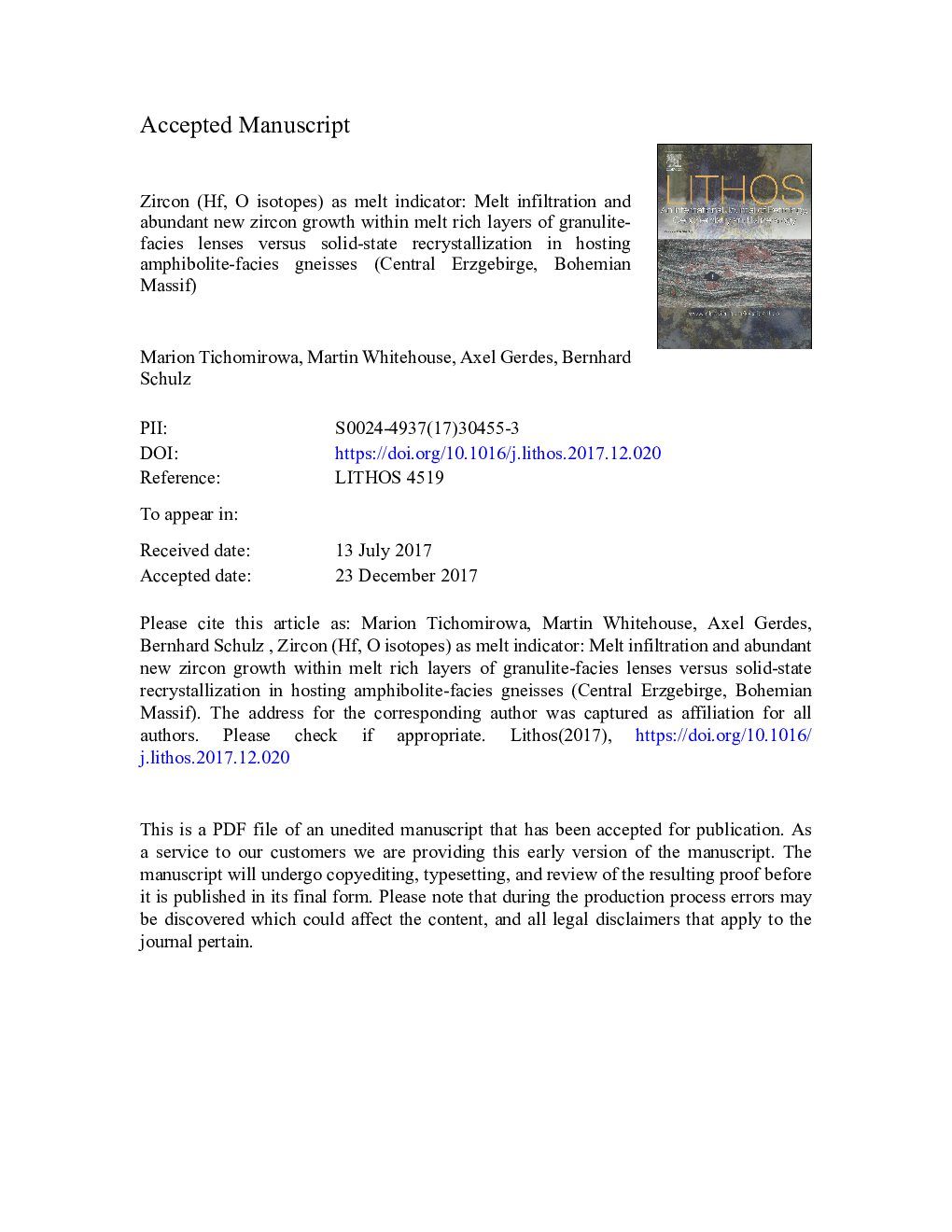| کد مقاله | کد نشریه | سال انتشار | مقاله انگلیسی | نسخه تمام متن |
|---|---|---|---|---|
| 8911687 | 1638622 | 2018 | 62 صفحه PDF | دانلود رایگان |
عنوان انگلیسی مقاله ISI
Zircon (Hf, O isotopes) as melt indicator: Melt infiltration and abundant new zircon growth within melt rich layers of granulite-facies lenses versus solid-state recrystallization in hosting amphibolite-facies gneisses (central Erzgebirge, Bohemian Massif
دانلود مقاله + سفارش ترجمه
دانلود مقاله ISI انگلیسی
رایگان برای ایرانیان
کلمات کلیدی
موضوعات مرتبط
مهندسی و علوم پایه
علوم زمین و سیارات
ژئوشیمی و پترولوژی
پیش نمایش صفحه اول مقاله

چکیده انگلیسی
In the central Erzgebirge within the Bohemian Massif, lenses of high pressure and ultrahigh pressure felsic granulites occur within meta-sedimentary and meta-igneous amphibolite-facies felsic rocks. In the felsic granulite, melt rich parts and restite form alternating layers, and were identified by petrology and bulk rock geochemistry. Mineral assemblages representing the peak P-T conditions were best preserved in melanocratic restite layers. In contrast, in the melt rich leucocratic layers, garnet and related HP minerals as kyanite are almost completely resorbed. Both layers display differences in accessory minerals: melanosomes have frequent and large monazite and Fe-Ti-minerals but lack xenotime and apatite; leucosomes have abundant apatite and xenotime while monazite is rare. Here we present a detailed petrographic study of zircon grains (abundance, size, morphology, inclusions) in granulite-facies and amphibolite-facies felsic gneisses, along with their oxygen and hafnium isotope compositions. Our data complement earlier UPb ages and trace element data (REE, Y, Hf, U) on zircons from the same rocks (Tichomirowa et al., 2005). Our results show that the degree of melting determines the behaviour of zircon in different layers of the granulites and associated amphibolite-facies rocks. In restite layers of the granulite lenses, small, inherited, and resorbed zircon grains are preserved and new zircon formation is very limited. In contrast, new zircons abundantly grew in the melt rich leucocratic layers. In these layers, the new zircons (UPb age, trace elements, Hf, O isotopes) best preserve the information on peak metamorphic conditions due to intense corrosion of other metamorphic minerals. The new zircons often contain inherited cores. Compared to cores, the new zircons and rims show similar or slightly lower Hf isotope values, slightly higher Hf model ages, and decreased oxygen isotope ratios. The isotope compositions (Hf, O) of new zircons indicate partial Hf isotope homogenization in the melt, and melt infiltration from an external source. New zircon was most likely formed by a peritectic reaction with melt above the wet solidus (peritectic zircon). Conversely, the amphibolite-facies host gneisses lack indications of significant melt production. Pre-metamorphic zircons experienced mainly solid-state recrystallization and variable Pb loss with only minor new zircon formation. However, subtle changes in cathodoluminescence pattern, in the Hf and O isotopes, and in the Lu/Hf, Yb/Hf ratios of zircons suggest that small volumes of melt were locally present. In difference to granulites, melt was internally produced. The detection of low degree melts (inferred from zircon geochemistry) is extremely important for the rheology because these amphibolite-facies rocks could act as large scale ductile shear zones. The new zircon data support a different P-T path for closely spaced amphibolite- and granulite-facies rocks.
ناشر
Database: Elsevier - ScienceDirect (ساینس دایرکت)
Journal: Lithos - Volumes 302â303, March 2018, Pages 65-85
Journal: Lithos - Volumes 302â303, March 2018, Pages 65-85
نویسندگان
Marion Tichomirowa, Martin Whitehouse, Axel Gerdes, Bernhard Schulz,